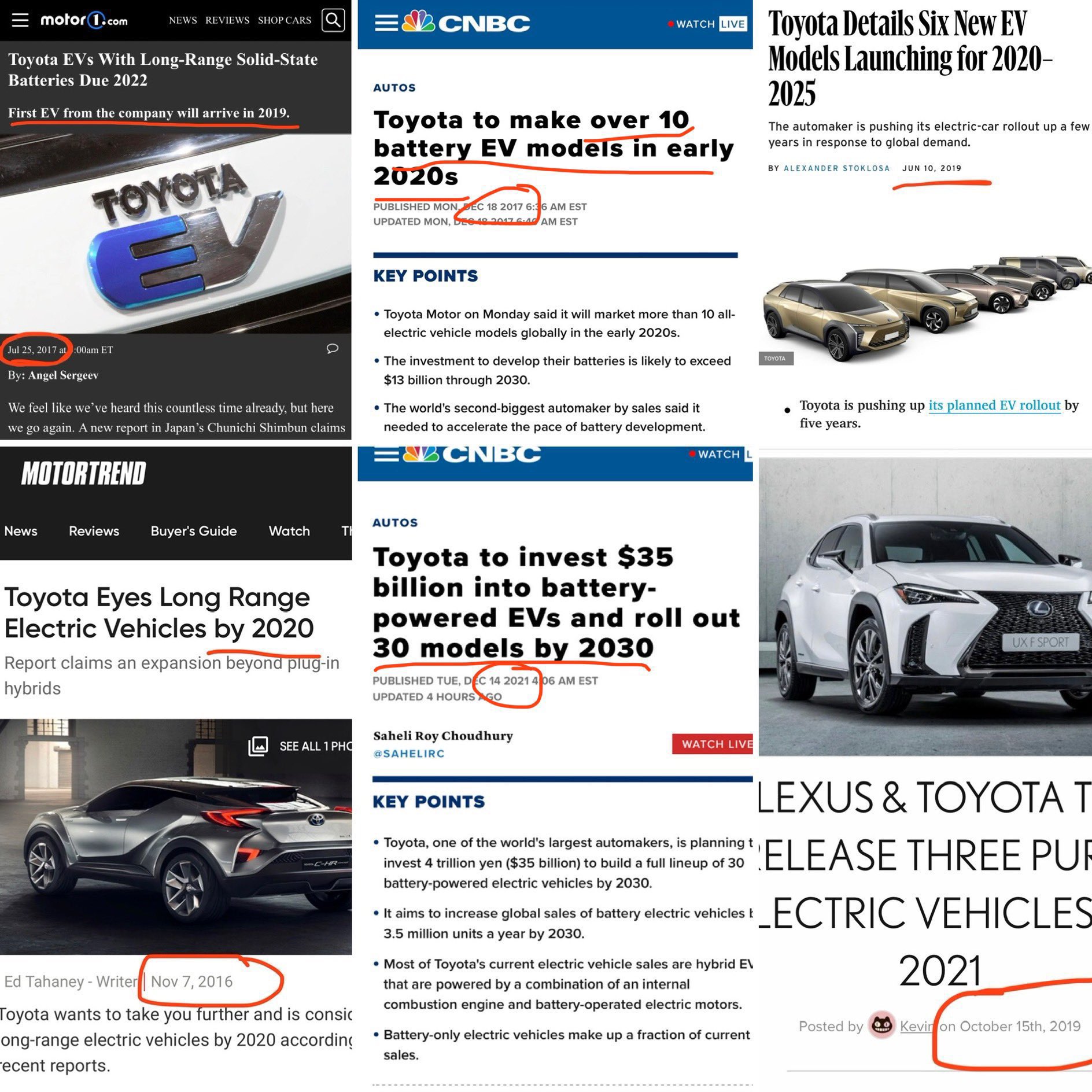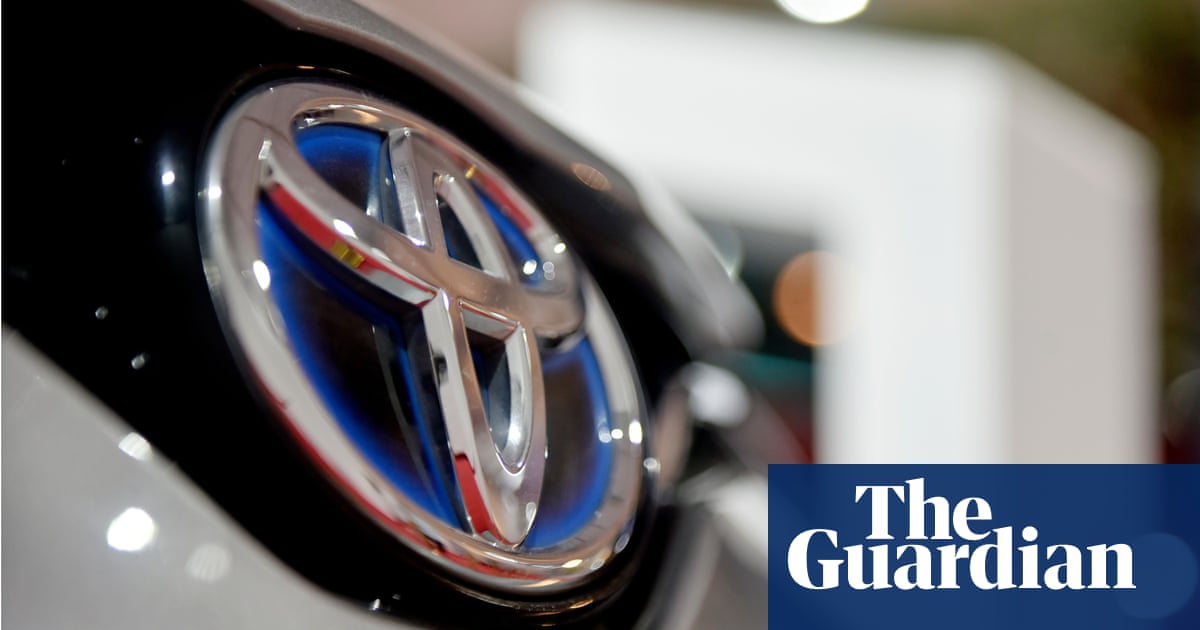Repost of a my previous comment on this elsewhere:
They have been “claiming”/ “announcing” this breakthrough since 2017 repeatedly. They STILL haven’t figured out how to mass produce it affordably to make it meaningful. They keep pushing out the date for when it will arrive for many years now.

It’ll come out when Tesla releases Full Self Driving for real
I don’t think Tesla is going to be the one announcing that.
Excellent sleuthing
Just in time for the commercially viable cold fusion.
Add on top of the nature of these ultra capitalist worldwide corporations, even if they were able to mass produce this affordably that would mean decommisioning tens of millions in already existing production infrastructure. Why would they do that when they can delay next gen tech for greater profit?
mm totally! seems like a very “i’ll just wait for the next gen to buy an EV” kind of thing
… like, even if it’s possible it’s not possible… just the amount of energy required to be transferred into that battery wouldn’t charge in any existing charging infrastructure
Ya that is the other major point. Toyota doesn’t have a charging network, and they didn’t build out a hydrogen network for their hydrogen car.
So even if they have this battery it would not be able to do what they claimed in practical use.
Their hydrogen cars work fine… as long as you live in a tiny area in california and have no desire to leave it lol
And are willing to pay “more” for expensive hydrogen.
Huh, the dude I know with a hydrogen car was bragging about the price of hydrogen compared to gas.
https://www.hydrogenfuelnews.com/why-is-hydrogen-fuel-so-expensive/8558411/
The Toyota Mirai comes with $15,000 worth of free fuel https://www.toyota.com/mirai/
Maybe that is what they where bragging about? Ask them in 3 years when the free fuel runs out.
Except none of those are about battery tech, just vehicles. Solid state batteries are a real thing that have shown promising advances as of late.
The title of the one in the top right is “Toyota EVs With Long-Range Solid-State Batteries Due 2022”
Here is a whole article on them making these past claims with sources https://thedriven.io/2023/07/05/solid-state-batteries-toyota-has-history-of-talking-big-on-ev-breakthrough-but-not-delivering/
Was going to reference your post.
Toyota spoofing.
OP’s article first claims 2025 and then claims 2027.
As per the image in my post Toyota first announced this in 2017 with a target of 2022… They just keep re-announcing it saying it is coming in about 3-5 years.
Worth pointing out there was a global pandemic in the middle of that timeline
Puts our Mitsubishi Outlander PHEV’s 30km after a 5 hour charge to shame!
Same with my Ford Escape PHEV’s 60km after 10-11 hours at home (4ish hours on a level 2).
Riiiiight.
Toyota is so far behind in the EV game that they are throwing out BS claims to give people pause who might be considering a purchase from all the other companies viable EVs right now. This is like 15 and 20 years ago when car makers were saying that their hydrogen cars were just a few years ago… which of course never materialized, but they used it as publicity stunts.
I have a hard time believing that this announcement is just a straight up lie. If they don’t have an actual working prototype, regardless of scale costs that they may be ignoring, wouldn’t they be open to a stakeholder suit for misleading the investors?
You are reading WAY too much into this. As many of other posts have already pointed out that YES this is feasible… but with very expensive, one-off prototype hardware. There’s no lie in that. It is simply exaggerating the HELL out of the truth because this ain’t going to see production for a long ass time (and most definitely at reduced specs).
As I mentioned in my post about hydrogen powered concept cars from like 20 years ago - many of them were indeed running (or sort of running), but they were far, far from near-production.
Toyota is in fact actively selling hydrogen cars. The Mirai is not awful, as long as you get a lease that includes free hydrogen. They’re probably losing tons of money on each one, but they’re selling them lol.
The Mirai is far, far from a “production” car.
They aren’t ignoring scaling if your read the article…
Often there are breakthroughs at the prototype stage but then scaling it up is difficult,” he said. “If it is a genuine breakthrough it could be a gamechanger, very much the holy grail of battery vehicles.”
Typical tabloid battery rubbish…
745 miles, assume 5 miles/kwh which is not unreasonable. That’s a 3.7Mwh battery (which my back of the envelope calcs would weight about 5 tonnes).
Charge that in 10 minutes you’d have to feed it from a 22Mw charger. So the output of a decent size offshore wind turbine. Per charger.
I haven’t got a clue how bloody heavy the connector would have to be… it wouldn’t be CCS, I can tell you that…
I find it funny how the media has just regurgitated their bullshit with essentially zero fact checking. This stuff is just outside the understanding of most people that they might not question it. To them this is Toyota making these claims. The company that made the '95 Camry which has been passed around to various family members and rolled up 300k miles. They trust Toyota. Maybe a little too much.
(It’s early and I probably calculated this on the wrong napkin, but) the smallest EV battery (in the mini cooper) claims a capacity of ~29kWh. Supplying this power in 10 minutes would require 170kW. If the supply is 240 volts single phase and perfect power factor, that would require over 700 amps.
Who knew old Doc from Back to the Future was building a Toyota Fast Charger the whole time. It’s crazy that all Toyota has needed all this time is to change their flux capacitor fluid.
DC fast charging, which this almost certainly refers to, isn’t done at 240 it’s done at the pack voltage which is usually between 300 and 900v. Most cars use 400v, Hyundai and Kia use 800v. The Hummer EV (and other forthcoming big GM vehicles) uses a clever pack that operates at 400v but can switch from parallel to series and charge at 800v. The “good” chargers go up to 1000v 500a.
So to get that same roughly 170kw at 400v is 425a - so a lot of chargers already exist that could handle a 30kwh pack just fine.
At full tilt 1000v 500a a charger could deliver roughly 80kwh in 10 minutes, (assuming it didn’t limit itself because of the heat) which is a lot but it’s not getting you 700 miles of range.
Watts is watts though. You can convert to any voltage you’d like, but short of reinventing the grid or only installing chargers at electrical sub stations, I don’t see how the grid can supply the required power at any kind of localized level. People can claim whatever they like for the standards that the converter is capable of, but ultimately the wires supplying mains voltage have a very real limit and can not supply massive amounts of current. Even in industry, power is increased by adding phases first, then increasing voltage second, because reinventing the grid to supply massive amounts of current is just not practical. So now what, are we going to pipe 10k7 volts to charge batteries? That’s “pick up the pieces” level of dead when the average idiot makes a mistake anywhere remotely close to the thing. If you want to try with 3 phase 480, now you have a tremendous amount of heat to deal with along with a bunch of extra complexity that isn’t needed. You also need the same local power infrastructure as most large businesses and industrial sites. That won’t be available in most of outskirt suburbia where demand will be the highest.
I don’t think the intention is for the average home to charge at these rates, but rather for charging stations to be faster. In large part even with 350kw DC fast charging stations (which already exist) the battery is the limiting factor, not the charger.
Essentially, yes these would kind of only be installed at electrical sub stations.
The stations that are already capable of 350kW must be using additional on site static storage that is able to supply this kind of power. Otherwise, it is junk marketing of design capacity and safety margins instead of real world limitations. Most homes in the USA have 240V with a 100A main breaker, and only if the home/local grid is relatively modern. Many homes only have 40A or 60A main breakers. It is impossible for 240V/100A to exceed 24kW under any circumstances other than breaking the physics of the entire universe. The only way to supply more power is to add local storage. 350kW is a lot of storage and engineering in practice to deliver. I’m willing to bet most of these setups are not performing anywhere near this. Heck any old average wall wort from your junk drawer will have a full bridge rectifier with 4× 1N4007 diodes. Those are rated at 1kV at 1A. By modern marketing standards they’d call that a 4A 4kV power supply. In the real world, that thing is pumping a massive 500mA at 5V and those diodes are probably still going to fail eventually.
Watts are the hard power limit that can’t be changed. The volts and current can seesaw against each other in a converter or transformer, but the combination can never alter the total available watts. Most people are not going to be able to buy an electric vehicle AND a massive static local supply source capable of high current output.
If you want centralized infrastructure, the scale of local storage is massive, nearly as much as everyone’s home solution combined, or it involves extremely high voltage distribution lines with extremely skilled labor managing it, or lots of dead people. I doubt the distribution line infrastructure can handle the types of loading that such random high current loads would induce. It would probably require massive local buffering infrastructure like momentum wheels to maintain the grid specification while multiple batteries are simultaneously charged at random. Any infrastructure requiring additional local storage must also justify itself against the fact that all of the EV batteries are not economically recyclable. Doubling the battery count for more convenient charging is just exchanging one environmental catastrophe with fossil fuel for another, even more so than it is already.
Again, large DC fast chargers are not for individual homes. Home 240v EVSEs run about 5-10kw and cost $500ish.
350kw chargers do exist and are not just marketing - they just aren’t being installed normal people’s houses. Here’s a DC fast charger for sale:
https://www.power-sonic.com/product/evdc-360na/
It uses 480v three phase at up to 440a to accomplish it. No one is going to get that in a residential setting. The unit itself probably costs on the order of $200k, and that wouldn’t include the construction of the site or any installation costs from the electrical company.
Why would you assume 240V? Maybe im missing something, but I charge my Ioniq 5 at 170kW all the time. 230kW on more powerful chargers. The grid seems okay with it.
The charger is connected to the mains electrical grid. The specification of the mains grid is what determines the total wattage that is available at any one time. Watts = Volts × Current. Watts can not be changed. If you know the voltage and current limitations of the mains grid, you know the hard limit on the watts supplied based on the limitations of the grid to your home. The only way to alter this equation is adding local storage.
An above average home is only capable of 240V/100A=24kW. This is due to the wire sizes used, and transformer at the pole, along with local grid infrastructure that connects them. Use this 24kW to help understand the scales involved too. Supplying 240kW safely, in the real world, without marketing idiots would require at least ten times the infrastructure that supplies your entire home. This could be done with a massive local battery, but it is not going to be cheap, small, or or simple. I can only speculate here, but the build specification is likely limited by temperature due to high current flow. The components capable of dealing with temperature tend to have higher power ratings. Marketing criminals tend to take these numbers and run with them when they are completely irrelevant to the real design constraints.
These aren’t designed for homes. Three phase power exists in the US for commercial customers that set up fast chargers. I grew up in Europe and we had three phase power for our residential AC as well.
bullshit
That’d make home charging practical. I want to believe–
No it wouldn’t. Battery tech isn’t the limitation on home charging speed at all. It’s the power available at your house that limits charging speed.
This tech would only help cars charge faster at dedicated charging stations.
I dont think there’s a single dedicated charging station in the world that supports that speed of charging either.
Well duh the vehicle and battery doesn’t exist yet, so of course their aren’t any chargers! The charging standards will have to be developed concurrently with the vehicle and deployed slowly over years.
Most countries in the world’s entire electrical grid wouldn’t be able to handle a full ev-ification of the nation’s cars as is- let alone replacing every single one of those cars with chargers that suck enough energy to charge 3~ of the normal modern ev’s range (250mi~) in 10 minutes (2x faster than the fastest modern evs) at once.
It would be taking a problem we already don’t have infrastructure to solve yet- and tripling it.
It doesn’t increase the total amount of energy needed vs regular evs. It might lead to higher power drain at certain popular charging times though. It also gives us the technology to help with that in the form of better energy storage. It sounds like they have improved energy density of batteries considerably to fit that range into an EV. That’s something we will need in the energy grid going forward.
It’s also possible to restrict charging rate during peak times to reduce load on the grid. There are other tricks that are possible as well including using connected vehicles not in use as additional energy storage for the grid.
If you can get enough electricity for EVs in the first place then this technology would actually be helpful overall I think.
And increasing the power available to every house, lamp post and car park is a big problem. It requires more investment than most utility companies are willing/able to make
Well that sucks.
Not really home charging times aren’t really a problem. You do don’t refuel a fossil fuel car at home.
The perception for me and maybe others is, I’ll drive somewhere and not be able to charge my vehicle unless I’m at home. That said, if a battery can last fricken 700 miles it’s a moot concern.
More and more places with electric car charging are available. Eventually we will replace gas stations with them. This strikes me as being far from reality and narrow minded at the same time. Maybe it’s different where you live?
Probably. I live in the South where trucks are more common than sense.
Home charging is already practical (overnight); it’s the primary means people with electric cars charge them.
This is why EVs remain a poor choice for people who drive long distances regularly.
True, though I’ll maintain most people aren’t those people, even though they might feel like they are
Depends on what car you have, and whether the area you drive through has good Level 3 chargers. My I5 charges so fast, and we rarely go anywhere that doesn’t have L3 chargers on the way, so charging isn’t really an inconvenience.
That’s really nice, and we’ll get there some day for everyone.
Right (and I knew as soon as I hit reply I should’ve phrased it better). What I mean is home charging becomes more attractive and useful. If you can charge in 10 min at a house it lessens the need for dedicated fueling stations. If we can quickly charge at (someone’s) home we don’t need gas stations.
If they could do it off of regular 120/240v they should just add charging plugs to all street lamps and charge electric vehicles a tax for power usage wether it’s public or private based off milage which also covers wear and tear on roads like the gasoline taxes do.
I’d be down for that. I’m sure it’d be called socialism though and we’d be stuck with the traditional gatekeepers. 🙄
I’m really sad that the gatekeepers go around unplugging electric cars, instead of trying to cut the ccharging cables while charging.
Cause that would very quickly be come a self correcting problem
At my place of work we’ve got one charging station. There’s a guy who parks his truck there every morning (comes in way early for some reason). He could park anywhere, even more convenient spaces, but always chooses that spot…So if you want to charge, good luck.
He literally sacrifices his morning, to come in super early, just to park his truck in the one charging station to fuck over someone with an EV.
That is the tiniest dick energy I’ve ever seen, lol.
Well, unless you want to go on long distance trips or wont be home for multiple days on end.
I wonder if a Mad Max sequel will focus on solar powered combat cars that struggle to cross vast distances under radioactive clouds…
Except for people who live in apartments, basement suites, student dorms, etc.
So only people who can afford $1M detached houses and $60k electric vehicles can have personal transportation after 2030 or whatever the cutoff is for ICE vehicles now.
As someone who lives in an apartment who cannot charge their EV at home, charging at public 6.6/12kw and fast chargers is more than enough to keep my battery filled, sure its like 2~5x more expensive than charging at your own home, but it’s still like 4x cheaper than what I was paying in gas per month comparatively.
Yeah it can be done for some. Probably wouldn’t work for myself though as I have a 150km commute to work each day so probably would have to sit and recharge at a public station every second day if not more. So 2 hours of commuting turns into 2.5+ hours.
Yea, its still unfeasible for many people with long drives to work or school- or infrastructure around them which isn’t fast enough or built at all.
The newest and best offers for sale nowadays could probably suit you- 300mi/480km~ is pretty common nowadays and the Ioniq 5/Ev6 charge back up to near full in about 30~ mins. But those cars are out of reach for anyone out of middle income/higher middle income.
Very weird turn of events given that Toyota has a history of being anti-EVs.
Toyota has historically been pretty conservative on tech changes. They were one of the last to move away from carburetors for example
Hmm, they were one of the first to mass produce hybrids, and the one of the first to try hydrogen. They must just have executives that really don’t like the idea of filling up slowly.
They were pro hydrogen but I think they realized that ship has sailed and EVs are here to stay for now
I think they were pro-hydrogen, and now they’re using hydrogen as an excuse not to do battery EVs.
People who have heard of hydrogen cars but haven’t looked at how inefficient and expensive they are still think that they’re the future.
I swear every other week I see a new video claiming Hydrogen cars are the future, despite our current tech just being inadequate to give them enough range, and how unsafe they are- ontop of how 95% of the world has next to 0 infrastructure to fuel said hydrogen fuel cars.
That’s not to mention the costly & environmentally unfriendly production of hydrogen in the first place which at current production rates could never even if multiplied by multiple degrees- fully support a hydrogen majority of cars on the road.
Hydrogen Cars, the uncleanest, most unpractical and expensive “clean energy!” alternative fuel…
Most of hydrogen’s problems are solvable - we can pack a car with hydrogen tanks, make hydrogen with electrolysis, build infrastructure, etc.
The big killer is price. Those hydrogen filling stations aren’t $1000 each like home chargers or $50,000 each like DC fast chargers, they’re something like 2 million dollars each. And you need them everywhere, there’s no home filling to carry most of your usage.
The hydrogen you put in them? You have to pay for not just the electricity that makes it into your car’s electric motor, but all the energy that was wasted along the way:

Nobody’s looking to spend all that money on filling stations, and nobody’s interested in paying 2-3x as much to fill their car.
Yes, money is usually the answer.
So incorrect. Look at any major truck company (Volvo, Hyundai, Cummins, etc) and where the investments are. Grey hydrogen stations are getting funding all over, here’s one in my extremely conservative and shit province https://www.src.sk.ca/news/sask-going-blue-hydrogen-hub-will-promote-further-investment-province. If you ignore all the investments and growth in the sector then sure, it’s never gonna happen.
Their announcements about products that are way better than anything that actually exists with no solid plans to actually bring it to market is actually just another flavor of anti-EV FUD.
It’s not the right time to buy an EV because our imaginary product is SO much better than any of those boring products, you should wait for it and keep buying our gas vehicles for now.
It’s depressing how cynical that is.
It’s depressing because its probably true and even if Toyota did create such a miracle tech, it would be insanely expensive to produce and thus purchase for the consumer. Not to mention with such an insane charge rate it would most likely never reach it due to the charge stations not supporting it and power infrastructure being unable to cope with such a load.
I was referring to Toyota’s strategy being cynical, not the comment.
Oh, Toyota’s strategy isnt Cynical, its a deliberate choice by the higher ups to champion hybrid, hydrogen and refuse to join in the EV party- its not some cynical idea that ev’s aren’t here to stay or wont take off.
Really too bad it’s going to require a subscription and monthly fees to get it. And that’s after the car payment.
No, you can’t see it.
She goes to another factory!
Toyota would also really like the grid to be able to support whatever they’re claiming, or the laws of physics to bend in their general direction to make this possible.
I’ll believe it when I see it.
So this battery is supposed to be: Half the weight AND half the volume AND half the price AND solid state!
And we are supposed to believe they can have that by 2025?
To charge for 745 miles, would require at least 150 kWh battery, meaning they’d have to charge at 1 MWh. AFAIK the most powerful chargers available today are about 750 kWh. So 1 MWh is possible. But very doubtful for a new solid state battery weighing and costing half of current batteries.
And we are supposed to believe they can have that by 2025?
The article says 2027, so a bit more time for infrastructure and development.
From the article:
The company expects to be able to manufacture solid-state batteries for use in electric vehicles as soon as 2027, according to the Financial Times, which first reported on Toyota’s claimed breakthrough.
Actually reading it again, it seems we are both wrong. 2025 is a “better” battery, 2027 is a solid state battery.
Having a solid state battery by 2027 is in no way impressive, since BYD already produce and sell fully electric cars with solid state batteries.
Toyota (partnered with Panasonic) has already broken ground on a new battery plant in NC, maybe that’s when they’re expecting production to begin there?
No doubt Panasonic makes some of the best batteries in the world, and is a much more trustworthy name regarding batteries than Toyota.
Still the claims of the article are ridiculous, and I doubt Panasonic would make claims of a solid state battery half the weigh size and prize of current batteries within 2-4 years.
it sounds like they might be producing them for cars to be out in 2027
but… they’re also working on making the manufactoring “simplified” and cheaper than lithium-ion batteries
i dont assume that’ll be done by '27
so i expect… costs to be high for the first year or two, and possibly only available in a few (low volume) car models
but we’ll see.
i hope they do surprise us greatly. but i have been sceptical of toyota regarding electric… which is weird coz they were among the first to make hybrids
Reading the article again, it merely states Toyota expect to have solid state battery by 2017, which is quite underwhelming, considering BYD already sell cars with solid state batteries.
I love Toyota, but this battery tech is still not viable until they figure out how to mass produce it for cheap.
This isn’t some university press release. Toyota is in the business of mass manufacturing, so I think they’ve probably already considered that.
In other news, Toyota is full of shit.
deleted by creator
Honestly, I don’t doubt that they have a battery that could scale up to give thar kind of performance. But, the infrastructure to support it is just not there. Hell, just to run power to the fast charges we have now is barely feasible without upgrading the utility to the property. Point it the bottleneck isn’t the battery, it’s getting that much power to the battery without resorting to cables and connectors used to provide shorepower to cruise ships.
My wife works for our local electricity board. She says that the grid isn’t even prepared for the uk governments target of no more petrol/diesel cars sold by 2030/35 the grid cant take the load of charging electric cars in every home.
Now put a toyota charging in 10 minutes on every driveway and your grid fails.
Its crazy.
If there’s a vehicle manufacturer I can trust to make a reliable battery with that kind of performance, it’s Toyota… Buuuuuuuuuuuut, I’ll believe it when I see it.























